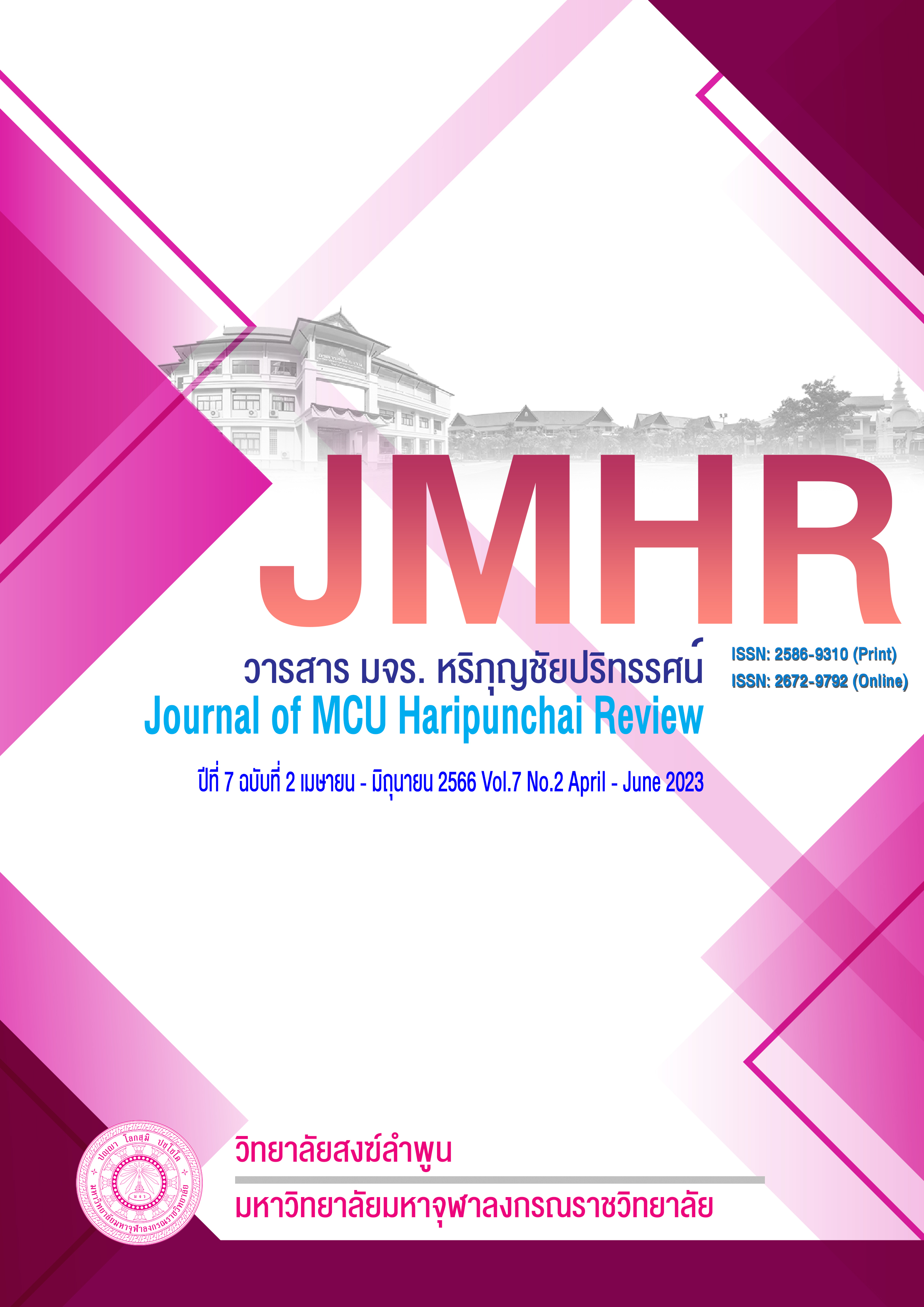การพัฒนาหลักสูตรส่งเสริมความสามารถการอ่านจับใจความสำคัญภาษาจีน โดยใช้เทคนิคการสอนเค ดับเบิลยู แอล เอช พลัส สำหรับนักเรียนชั้นมัธยมศึกษาปีที่ 5
Main Article Content
บทคัดย่อ
งานวิจัยนี้มีวัตถุประสงค์เพื่อ 1) สร้างและหาค่าดัชนีประสิทธิผลหลักสูตรส่งเสริมความสามารถการอ่านจับใจความสำคัญภาษาจีน โดยใช้เทคนิคการสอน เค ดับเบิลยู แอล เอช พลัส สำหรับนักเรียนชั้นมัธยมศึกษาปีที่ 5 และ 2) ศึกษาผลการใช้หลักสูตรส่งเสริมความสามารถการอ่านจับใจความสำคัญภาษาจีน โดยใช้เทคนิคการสอน เค ดับเบิลยู แอล เอช พลัส สำหรับนักเรียนชั้นมัธยมศึกษาปีที่ 5 กลุ่มตัวอย่าง ได้แก่ นักเรียนชั้นมัธยมศึกษาปีที่ 5 แผนการเรียนภาษาจีน ได้มาจากสุ่มแบบกลุ่ม จากโรงเรียนสหวิทยาเขตบุญวาทย์ 1 โรงเรียน และโรงเรียนแม่เมาะวิทยา อำเภอแม่เมาะ จังหวัดลำปาง จำนวน 1 ห้องเรียน จำนวน 18 คน ภาคเรียนที่ 2 ปีการศึกษา 2565 ซึ่งเป็นการวิจัยเชิงทดลองเบื้องต้น แบบแผนที่ใช้ในการทดลองครั้งนี้ คือแบบกลุ่มเดียวทดสอบก่อน – หลังการทดลอง เครื่องมือที่ใช้ในการวิจัย ได้แก่ หลักสูตร คู่มือการใช้หลักสูตร แบบทดสอบวัดความสามารถการอ่านจับใจความภาษาจีน สถิติที่ใช้ในการวิเคราะห์ข้อมูล ได้แก่ ค่าเฉลี่ย ร้อยละ ส่วนเบี่ยงเบนมาตรฐาน และการทดสอบค่าที ผลการวิจัยพบว่า 1. หลักสูตรส่งเสริมความสามารถการอ่านจับใจความสำคัญภาษาจีนโดยใช้เทคนิคการสอนเค ดับเบิลยู แอล เอช พลัส สำหรับนักเรียนชั้นมัธยมศึกษาปีที่ 5 มี 7 องค์ประกอบ ได้แก่ 1) ความเป็นมาและความสำคัญของหลักสูตร 2) หลักการของหลักสูตร 3) จุดมุ่งหมายของหลักสูตร 4) เนื้อหาของหลักสูตร 5) การจัดกิจกรรมการเรียนการสอน 6) สื่อ/แหล่งการเรียนรู้ และ 7) การวัดและประเมินผล ส่วนเนื้อหาของหลักสูตร มี 4 หน่วยการเรียนรู้ รวมทั้งสิ้น 16 ชั่วโมง ได้แก่ หน่วยที่ 1 การอ่านจับใจความสำคัญภาษาจีน บทสนทนา 4 ชั่วโมง หน่วยที่ 2 การอ่านจับใจความสำคัญภาษาจีน เรื่องสั้น 4 ชั่วโมง หน่วยที่ 3 การอ่านจับใจความสำคัญภาษาจีน นิทาน 4 ชั่วโมง และ หน่วยที่ 4 การอ่านจับใจความสำคัญภาษาจีน บทความจากสื่อ 4 ชั่วโมง ค่าเฉลี่ยความเหมาะสมของหลักสูตรในภาพรวมอยู่ในระดับมาก คู่มือการใช้หลักสูตรในภาพรวมมีความเหมาะสมอยู่ในระดับมาก และหลักสูตรมีค่าดัชนีประสิทธิผลอยู่ที่ 0.6613 2. นักเรียนที่เรียนด้วยหลักสูตรส่งเสริมความสามารถการอ่านจับใจความสำคัญภาษาจีนโดยใช้เทคนิคการสอนเค ดับเบิลยู แอล เอช พลัส มีความสามารถการอ่านจับใจความสำคัญภาษาจีนหลังเรียนสูงกว่าก่อนเรียน อย่างมีนัยสำคัญทางสถิติที่ .05
Article Details

อนุญาตภายใต้เงื่อนไข Creative Commons Attribution-NonCommercial-NoDerivatives 4.0 International License.
เอกสารอ้างอิง
กระทรวงศึกษาธิการ. (2551). หลักสูตรแกนกลางการศึกษาขั้นพื้นฐานพุทธศักราช 2551.
กรุงเทพฯ : คุรุสภาลาดพร้าว.
กาญจนา คุณารักษ์. (2553). การออกแบบการเรียนการสอน. (พิมพ์ครั้งที่4). นครปฐม :
มหาวิทยาลัยศิลปากร วิทยาเขตพระราชวังสนามจันทร์.
จันทรรัตน์ จาดแห. (2564). การพัฒนาหลักสูตรส่งเสริมความสามารถในการอ่านจับใจความ
สำคัญ โดยใช้กลวิธีการสอนแบบดี อาร์ ที เอ สำหรับนักเรียนชั้นประถมศึกษาปีที่ 3.
วิทยานิพนธ์ปริญญาครุศาสตรมหาบัณฑิต สาขาวิชาหลักสูตรและการสอน
มหาวิทยาลัยราชภัฏลำปาง.
ธํารง บัวศรี. (2542). ทฤษฎีหลักสูตร : การออกแบบหลักสูตรและพัฒนา. กรุงเทพฯ : ธนธัช.
บันลือ พฤกษะวัน. (2557). มิติใหม่ในการสอนอ่าน. (พิมพ์ครั้งที่ 2). กรุงเทพฯ :
ไทยวัฒนาพานิช.
บุญชม ศรีสะอาด. (2553). การวิจัยเบื้องต้น. (พิมพ์ครั้งที่ 8). กรุงเทพฯ : สุวีริยาสาส์น.
มารุต พัฒผล. (2556). การประเมินหลักสูตร เพื่อการเรียนรูและพัฒนา. กรุงเทพฯ :
จรัลสนิทวงศการพิมพ.
สำนักวิชาการและมาตรฐานการศึกษา. (2552). ตัวชี้วัดและสาระการเรียนรูแกนกลางกลุมสาระ
การเรียนรูภาษาตางประเทศ ตามหลักสูตรแกนกลางการศึกษาขั้นพื้นฐานพุทธศักราช
กรุงเทพฯ : ชุมนมสหกรณการเกษตรแหงประเทศไทย.
สำนักวิชาการและมาตรฐานการศึกษา. (2561). คู่มือการดำเนินงานกิจกรรมโครงการส่งเสริมนิสัยรักการอ่านและการพัฒนาห้องสมุด ประจำปีงบประมาณ 2561. [ออนไลน์]. เข้าถึงได้จาก http://academic.obec.go.th/articledetail.php?id=71&action=view.
สืบค้นเมื่อ 2 พฤษภาคม 2565.
Carr, E. and Ogle D. (1987). K-W-L Plus: A Strategy for Comprehension and
Summarization. Journal of Reading, 30 (May) : 626-631.
Conner, Jennifer. (2004). Instructional Reading Strategies: KWL (Know, Want to Know Learn). Accessed January 7, 2004. available from


